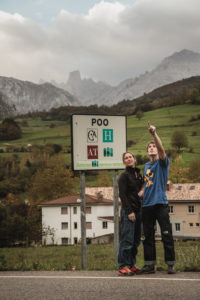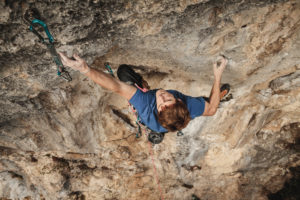El Cantu, en Teverga, Asturias es una zona típica de búlder; un revoltijo de grandes bloques de piedra caliza en las laderas debajo de las paredes. Con alrededor de más de 100 problemas de todos los grados distribuidos en un área amplia, hay muchas cosas para hacer. El Cantu tiene una caliza gris excelente, compacta, que forma pendientes frustrantes en igual medida que pequeñas regletas. “¡Uno de mis problemas favoritos de El Cantú fue Houdini, un 8a bastante corto de 5 movimientos, que terminó con un doble lance lateral espectacular!” dijo James Pearson Once Upon a Climb cuando le llevé alli hace 4 años! Grabado por Muérdago Films Foto 300bolts
El Cantu is a typical bouldering area; a jumble of big limestone blocks on the slopes below the crags. With around 100 problems of all grades spread over a wide area, there are plenty of things to go at. El Cantu is superb, compact, grey limestone, which forms frustrating slopers in equal measure to tiny crimps.
As James Pearson said “One of my favourite problems from El Cantu was Houdini, a rather short, 5 move 8a, which ended with a spectacular sideways double dyno!” Filmed by Muérdago Films Photo 300bolts
James Pearson Guest Blog – Roca Verde Road Trip – Day 6 – Bouldering
“Sometimes our trips are meticulously planned and sometimes they just happen, often at the whim of others. Our Roca Verde road trip was the latter. Touching down at night in late October to Santander after a week of work in England we were looking forward to a climbing break – but we hadn’t a clue what to expect – all we knew was that we had seven days guided round the region.
Our good friend Richie Patterson, the author of the first English language guide to a block of north-west Spain he’d christened Roca Verde, had invited us; but we didn’t really know where we were going or what the area encompassed. We’d actually not climbed in Spain for a while as we are always looking to go a little ‘off-piste’ and the crowds and polish of the major destinations, however good the climbing, don’t really appeal. So when Richie promised unpolished rock, empty crags and plenty of great routes to go at – we were intrigued enough to give it a go!”
Day 6 – Bouldering – El Gachu, El Cantu and Cabo Negro – Central Asturias
Although not perhaps the strong point of Asturias, Richie was keen for us to sample some of the bouldering, and he’d planned out one long, crazy day to take in all Asturias had to offer. Knowing me quite well I think he knew that I’d appreciate it a bit more than Caro, and promptly warned her that it would be somewhat of an acquired taste…English style!
We began the day at El Gachu, a hidden gem, tucked away on a hillside, halfway up the 1200m pass of San Lorenzo. It’s a super steep wall of quartzite that reminded me heavily of the Bowderstone in the Lake District, with a load of hard problems up to 8b+, 50 meters long and overhanging in its entirety, the problems climbed really well, even if they were not the most inspiring of lines. The location however was a spectacular, isolated from the rest of the world as you look down on the Teverga spread out far below.
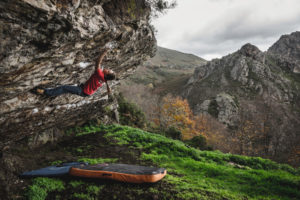
Once again pushed for time, we hopped in the car and dropped back down to Teverga. El Cantu is a somewhat more typical bouldering area; a jumble of big limestone blocks on the slopes below the crags. With around 100 problems of all grades spread over a wide area, there are plenty of things to go at. El Cantu is superb, compact, grey limestone, which forms frustrating slopers in equal measure to tiny crimps. One of my favourite problems from El Cantu was Houdini, a rather short, 5 move 8a, which ended with a spectacular sideways double dyno! The easier problems are just as good, and brought with them something that limestone bouldering so often lacks – lines… After a few more problems across the various blocks we settled for lunch of fresh cooked empanada, a local treat of a flat bread filled with chorizo, and chilled out as the sun danced across the hillside opposite lighting up the sectors we’d climbed on previously.
Tired but happy we dozed in the car as Richie drove us North to the coast, to the last venue of the day, and the trip. Very much a coastal region, Asturian climbers had been exploring the cliffs and boulders next to the Atlantic for many years and found some impressive venues. Cabo Negro was one of the most famous and popular, a bunch of rough black boulders sat on a wide tidal ledge, just above the pounding sea. Facing west there were views of the port of Aviles and Richie swore it was perfectly placed to enjoy superb sunsets!
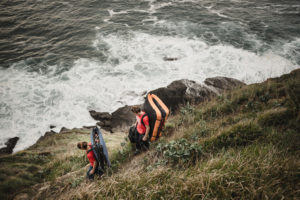
Arriving at the boulders after a short walk along the cliff top path, it was atmospheric to say the least. Substantial waves were crashing in, over the ledge, and sending plumes of spray 10 metres into the air. Sadly, this combination of wind and waves meant that much was too wet to climb, and we began to get a little nervous as we realised the tide was already on its way back in.
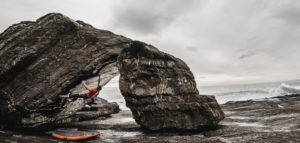
Then, whilst traversing the thinnest part of the ledge to check out the furthest boulders, I turned back as I heard a high-pitched scream and several choice French curse words. For a moment Caroline disappeared behind a huge wall of spay, luckily to re-appear a second or too later, although by now soaked to the skin! At this point we decided that discretion was the better part of valour, and that perhaps we should cut our visit short. I was reluctant to leave without trying a single problem, and so grabbed my boots to quickly play on a few of the drier boulders as Caro shivered semi-naked!!
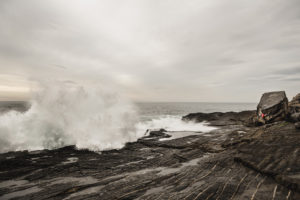
Day 7 – Homeward bound
Settling down on the plane and thinking about the week that had whizzed by, I thought back to Richie’s emphasis of the ‘difference’ we’d find in the north of Spain. This was Spain, but not as we had known it before: the crags were empty and unpolished, the climbing superb, and the ambience was like a snapshot of the rural past, all in the most spectacular, and very, green settings!
Caro had christened it ‘tufaland’ on day one as we marvelled at the amount of rock in La Hermida but the truth was that there seemed to be a bit of everything, especially in the west. With Quirós and Teverga providing complementary and contrasting venues so close together, there are a ton of great routes across all grades and styles, enough for even the pickiest of climbers.
Although far too short, our trip had given us a taste of these “new” regions of Spain, and all they have to offer – and we hadn’t even made it to Leon (the remaining third of the Roca Verde guide) We left surprised, happy and content, knowing that Roca Verde was one part of Spain to which we cant wait to return.
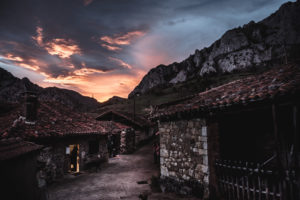
You can check out James and Caro’s adventures in northern Spain in a short series of movies they made about the place: their Roca Verde Road Trip.
They’re all on Epic TV so here’s some links
Part 1 – https://youtu.be/n5bil2d1Br4
Part 2 – https://youtu.be/yq37n0zej9A
Part 3 – https://youtu.be/HQ6RheBVFog
James Pearson Guest Blog – Roca Verde Road Trip – Day 1 + 2 Eastern Asturias
“Sometimes our trips are meticulously planned and sometimes they just happen, often at the whim of others. Our Roca Verde road trip was the latter. Touching down at night in late October to Santander after a week of work in England we were looking forward to a climbing break – but we hadn’t a clue what to expect – all we knew was that we had seven days guided round the region.
Our good friend Richie Patterson, the author of the first English language guide to a block of north-west Spain he’d christened Roca Verde, had invited us; but we didn’t really know where we were going or what the area encompassed. We’d actually not climbed in Spain for a while as we are always looking to go a little ‘off-piste’ as the crowds and polish of the major destinations, don’t really appeal. So when Richie promised unpolished rock, empty crags and plenty of great routes – we were intrigued enough to give it a go!” James Pearson
Day 1 – La Hermida – Cantabria
Arriving in the dark, never gives a sense of the surroundings so it was a big surprise to wake up in an enormous, steep-sided valley. Not only because it was filled with huge crags but also because it was incredibly green, tree-lined and not at all ‘Spanish’ looking.
The Desfiladero de La Hermida marks the Eastern border of the mountains of the Picos de Europa and is the one of the major tourist routes into the heart of the mountains. Our hotel, La Cuadrona, a beautifully restored traditional building, was a bit further north, at the centre of the climbing in the village of La Hermida itself. Known as the climber’s bar the owners were incredibly friendly, used to dealing with foreigners and knew to provide the sort of ‘mountainous’ breakfast that it turned out we were going to need for the day!
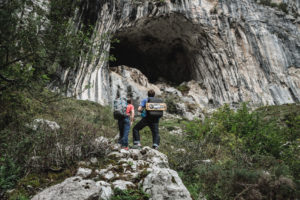
I say that because Richie had arranged a bit of a treat, a visit with one of the busiest local equippers, Alberto Hontavilla, to his latest work in progress. A stack of exceptional routes in the huge cave of Carcalosa. Imposing and tufa-strewn it’s also situated on the ‘wrong’ side of the river and perched above a slope that necessitates a 45 minute hike. Braving the icy water we crossed and made our way up the hillside, marveling at the dedication needed to even create the path, never mind to slog with all the gear needed for equipping. Secretly we wondered if this was not the beginning of just another of Richie’s ‘brilliant ideas’, yet as we pulled on the last of the fixed ropes and the full extent of the cave came into view, we realised it was totally worth it. A deep, seemingly bottomless hole flanked on either side by steep, tufa covered walls. Not at all the type of limestone we were expecting!
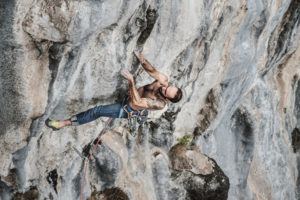
All in all there are around 50 routes from 6a and up to 8b, with many projects still to climb. Slap bang in the middle of the main wall is Dimensión Paralela 7c+ and the “tram line” tufas just have to be climbed. At 40 meters long, it is an endurance marathon, and doesn’t give up anything until just before the chain. At the end of the day we couldn’t have been more pleasantly surprised! Perfect rock, brilliant routes, friendly locals, and superb views. Luckily for us, this feeling would become more and more common as the week went on!
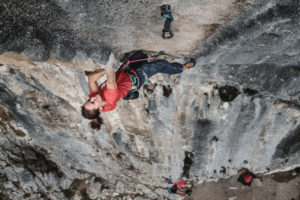
Day 2 – Poo de Cabrales – Eastern Asturias
A second giant breakfast eased our discovery that rain had fallen in the night – you don’t get to be green and lush without a little water. Our intention had been to head straight to Poo de Cabrales, one of the most well known sport-climbing venues around the Picos. But, worried it may be raining there too, Richie suggested a quick-hit at the roadside of Urdon just a few of km from the hotel, to do a couple of routes while the weather settled. He swore Urdón had a climate of its own and was ‘almost always-dry’, yet with the roads still soaking and the mist hanging low, I wasn’t sure I believed him. Happily the walk in this time was short, around one minute, and there were no rivers to cross. We climbed a pair of excellent wall climbs, 6c and 7c, on solid orange and grey rock, that despite the falling rain were in perfect condition.
Heading out of the valley from it became pretty obvious that it had been a localised shower as clear blue skies greeted us at the end of the half-hour drive to Arenas de Cabrales, a short hop from the crag. Grabbing some bread, chorizo and a chunk of the famously fierce Cabrales blue cheese we were soon in T shirts and marvelling at the views of Picu Urriellu from the car-park below Poo.

As we arrived at the crag it was immediately obvious why Poo was so popular. A ten-minute hike leads up to a compact little crag, with several sectors ranging from slabby to steep. Set against the dramatic backdrop of the magnificent Picos, Poo is one of the most visually pleasing crags of the area, and the climbing’s not half bad either. There are too many good routes to choose a favourite, and on national pride alone I should really mention Englishmen, 7c, opened in 1991 by our friends Nick Dixon and Andy Popp. However the most memorable route of the day, if only for the never-ending discussion of the grade, had to be Lord Byron, an intense and athletic 7c(+) at the Horóscopo sector.
You can check out James and Caro’s adventures in northern Spain in a short series of movies they made about the place: their Roca Verde Road Trip.
They’re all on Epic TV so here’s some links
Part 1 – https://youtu.be/n5bil2d1Br4
Part 2 – https://youtu.be/yq37n0zej9A
Part 3 – https://youtu.be/HQ6RheBVFog
Área de escalada de Teverga por dron!!
Para aquellos que no saben cuánta roca tenemos o qué se están perdiendo si no han escalado en Teverga, aquí hay una vista aérea de unos de los 35 (o más) sectores que hay en este destino espectacular. Aquí hay cerca de 1000 vías y gracias al trabajo del club de montaña @grupoajuasobia, se abren más rutas y sectores cada año.
Se puede ver el tamaño y la cantidad de roca si se nota los coches en la carretera …
Se puede comprar la guía de la zona aqui
Y si se busca alojamiento tenemos una Casa de Aldea muy cerca http://bit.ly/CasaQuirosEsp
New Topo for Mergullo, Asturias
Here’s a crag that I couldn’t squeeze into Roca Verde 2. It appeared in the first edition but as it’s a bit of a ´locals´venue I didn’t have the space in the expanded version.
Mergullo is a small venue that overlooks the ‘Senda Verde’ just outside Oviedo. It’s probably the closest crag to Oviedo and can be accessed on bike or by walking. However, it’s not the most popular venue and although there are some decent routes, the lack of traffic, the crag’s orientation and the two massive quarries nearby mean that the routes are quite dusty, making them difficult to enjoy. The climbing is hard and fingery and there aren’t any easy routes TBH…but the routes are good they just need a clean.
Remember you can buy the full Roca Verde edition 2 here: Buy Roca Verde 2
- « Previous Page
- 1
- 2
- 3
- 4
- 5
- 6
- …
- 11
- Next Page »
